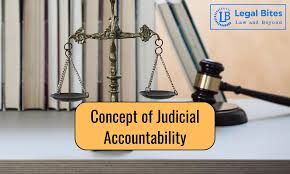INTRODUCTION:
Judicial accountability refers to the mechanisms through which the judiciary is answerable for ethical conduct, efficiency, transparency, and integrity—while still preserving its independence. It aims to ensure that judges uphold constitutional values, avoid misconduct, and deliver fair and timely justice
Objectives & Need
- Safeguard impartiality: Avoid bias, corruption, and nepotism.
- Enhance public trust: Boost confidence in judicial fairness and integrity.
- Ensure efficiency: Combat case backlog and discourage delays.
- Transparent appointments: Make judicial selection less opaque and nepotistic
Historical Context
- Pre-independence: Sapru Committee (1945) shaped post-WWII judiciary—advocated fixed tenure, separation from the executive.
- Collegium system: Emerged via the Supreme Court’s Three Judges Cases (1981–1998), asserting judicial primacy in appointments
- NJAC era: Proposed in 2014, struck down in 2015 for threatening independence
Current Mechanisms
- Collegium System: Senior judges appointers; criticised for opacity and nepotism but central to judicial autonomy
- In-house Procedure: Internal inquiries into misconduct; confidential, non-binding, and rarely punitive
- Impeachment Process: Under Articles 124/217 via Judges (Inquiry) Act, cumbersome, onerous; only one successful case
- RTI & Transparency: SC’s 2019 decision made the Chief Justice’s office RTI‑compliant, but accountability remains limited
- Judicial Standards: 1997 ‘Restatement of Judicial Values’—voluntary ethical ethos lacking enforceability
- Digitisation Initiatives: E‑Courts and NJDG track case disposal and judge performance
✅ 5. Arguments in Favour
- Protects independence: Shields judges from executive/legislative pressure
- Prevents politicisation: Keeps the judiciary insulated from transient political influences
- Upholds separation of powers: Ensures judicial autonomy in appointments and decision-making
❌ 6. Criticism
- Opacity: Collegium lacks transparency, invites nepotism
- Impacted public trust: Secret judicial processes undermine credibility
- Weak misconduct action: In-house inquiry and impeachment are ineffective
- Chilling effect of contempt: Harsh contempt laws block constructive critique
- Post-retirement bias: Judges taking government posts post-retirement undermine impartiality.
- Backlog impacts fairness: Pendency lowers quality and trust in the judiciary
🔧 7. Suggestions for Reform
- Form a National Judicial Oversight/Complaints Commission: Statutory body with expert and public representation to investigate misconduct
- Upgrade collegium transparency: Publish minutes, reasons, and eligibility criteria
- Make Code of Conduct binding: Enforceable judicial ethics with penalties
- Introduce performance reviews & asset disclosures: Annual public accountability reports
- Fast-track impeachment process: Streamline Judges (Inquiry) Act timelines; continue investigations post-resignation
- Reconsider All-India Judicial Service (AIJS): Standardise recruitment, reduce vacancies, enhance diversity
- Expand digitisation & live hearings: Public access to court proceedings
- Curate ethical training: mandatory, regular programs via judicial academies.
- Impose post-retirement cooling-off: Delay government roles to reduce conflict of interest.
Vision for the Future
Judicial accountability, envisioned correctly, shouldn’t be a threat but rather a guardian of judicial dignity. By embedding mechanisms that
- Publish Collegium deliberations.
- Empower an independent oversight body.
- Mandate ethical compliance.
- Enhance performance transparency, and
- Bolster court infrastructure.
- India can build a judiciary that is trusted, accessible, efficient, and constitutionally anchored. This reformed framework can curb nepotism, rein in misconduct, curb undue activism, and preserve the judiciary’s role as a fearless defender of rights.
Judicial accountability in India requires a delicate balance—embedding checks and transparency without compromising judicial independence. Through statutory oversight, binding ethical standards, transparent appointments, performance monitoring, and digitization, the judiciary can become more credible and efficient. Ultimately, both judicial autonomy and accountability are complementary pillars essential for upholding the rule of law and preserving democratic legitimacy.
8. Conclusion
Judicial accountability in India requires a delicate balance—embedding checks and transparency without compromising judicial independence. Through statutory oversight, binding ethical standards, transparent appointments, performance monitoring, and digitization, the judiciary can become more credible and efficient. Ultimately, both judicial autonomy and accountability are complementary pillars essential for upholding the rule of law and preserving democratic legitimacy.
CONTRIBUTED BY – ANSHU (INTERN)

